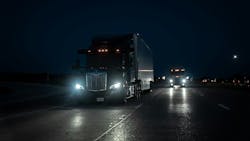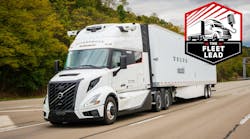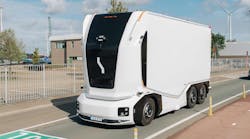Autonomous trucking advances, but OEM points to gaps before wide deployment
Key takeaways
- Autonomous pilots are shifting from tests to real freight, but scaling requires purpose-built OEM platforms and deeper carrier trust.
- Developers must prove clear operational value—yard moves, TMS integration, and real-world utility will determine adoption, not just tech demos.
- Early driverless lanes will stay limited; only certain routes fit Level-4 autonomy, and broad deployment will take far longer than the headlines suggest.
Autonomous hauls have arrived—but there’s much work left to do before the technology will reach everyday carriers.
That’s the takeaway from ACT Research’s recent webinar on the future of commercial vehicle automation featuring expert guests from Kodiak, Paccar, and JB Hunt. ACT is releasing a market report and forecast on the state of autonomous near the end of this month.
“A few years ago … It was still this dream that was just kind of in the works,” ACT Research analyst and event host Lydia Vieth said. “It’s really cool to see this year that we are seeing actual operations happen.”
Looking back on this year, autonomous truck developers reached major milestones:
- Kodiak began hauling frac sand for Atlas Energy without human drivers in January.
- Aurora announced its commercial driverless hauls in Texas in May.
- Bot Auto completed its first humanless validation run in September on Interstate 10.
- Plus and International launched customer fleet trials between Laredo and Dallas in September.
“Those are huge milestones for what was previously solely testing,” Vieth said.
These milestones are great cause for celebration, but the developers aren’t resting on their laurels just yet. There is a long, winding path to take autonomous trucks to wider market adoption.
“The biggest challenge is just that there’s a lot of complexity to orchestrate and a lot of work to do,” Paul Konasewich, general manager of the Paccar Innovation Center, said. “For trucking, this is a version 1.0 and so there’s a lot of things to learn along the way.”
Piloting autonomous technology is not the only ingredient to build demand for driverless trucks.
What do commercial vehicles need to go autonomous?
An autonomous truck market will need more than simulations, affordable sensors, or dedicated hubs. It will also need a dedicated equipment platform and carrier buy-in.
A purpose-built OEM platform
An autonomous system needs many partners that each specialize in the myriad aspects of autonomous operation: the truck and its parts, the hardware and software to automate it, and the commercial carrier to operate it. But even that is not so simple: safety requires that the truck and its parts must be specially-built for this use case.
“In order to put an autonomous driver safely in a truck, you really need a purpose-built platform with all of the proper redundancy for brakes, steering, power, and you go through a list of about 20 other things,” Konasewich explained.
A purpose-built truck platform is important not only for safety but carrier buy-in. The idea of a simple upfit is harder to sell to someone like Josh Hankins, SVP of safety and security for JB Hunt Transport Services.
“To move out of a bolt-on retrofit system into an integrated, redundant system—that’s where trust and some confidence is built from us on the carrier side,” Hankins said.
Manufacturers are already working hard to develop those platforms. Volvo is developing autonomous-specific manufacturing for its VNL platform. Daimler is iterating on autonomous variants of its Cascadia. International is engineering its trucks for autonomous production.
How autonomous truck developers changed
Not every autonomous trucking company was able to reach the heights of driverless runs. The players have changed but the game remains the same.
Embark, in 2023, laid off 70% of its workforce and was acquired by Applied Intuition for $71 million (Applied Intuition is still involved in autonomous trucking today and recently partnered with Isuzu to develop autonomous operations in Japan). Locomation quietly laid off staff and sold its operation in early 2023. In 2024, after many shady controversies, TuSimple moved its assets to China to focus on AI-generated entertainment.
On the other hand, Waabi entered the space in 2021, led by longtime autonomous expert Raquel Urtasun. The company already has a powerful partnership with Volvo.
Some former TuSimple employees and expelled leader Xiaodi Hou founded Bot Auto in 2023 to continue developing autonomous trucking. They announced their first driverless run in September.
“While there are some new entrants, they’re not new to the industry or new to the technology,” ACT Research analyst Ann Rundle said. “What’s remarkable is how quickly they’ve come up to speed, driving autonomous freight right now in the Texas triangle and even looking to expand two routes into adjacent states.”
“Now, in 2025, you have several platforms from at least three of the four major OEMs that are in late stages of development,” Konasewich said. “In 2020, this was more of an idea, and now it’s more of a soon-to-be-complete R&D project.”
Autonomous still needs a value proposition
Kodiak’s Goff mentioned that, besides a dedicated platform, an autonomous system also needs to be desirable for fleets.
“How do you actually make this useful for people? Just because the technology can drive from point A to point B doesn’t mean you have that utility part,” Goff said. “Part of why we do these pilots is to pressure test that product. … That first and last 100 feet in a yard is really challenging from an autonomy perspective.”
The minutiae of working through shipping/receiving or integrating with a TMS are, according to Goff, “the difference between this being something of a curiosity and something useful.”
“That’s where we’re going to see the most work over the next few years,” Goff said. “Building out that product case to expand the business case for where these pieces make sense and where this can actually add value.”
Even though sensor and computer suites have plummeted in cost over the last decade, OEMs might still ask a high price for an autonomous truck. Paccar’s Konasewich noted that another problem will be getting fleets to consider the benefits of autonomy beyond cost-per-mile “because we know the cost side, especially in the early days, is tough.”
“In the hardware part of autonomy, the big expensive things are the computer and the LiDAR—and the cost curves are amazing. The prices come down in ways that, in the truck industry, we’re not used to,” Konasewich said. “That’s definitely going to be a tailwind in the early days.”
Goff predicted that adoption of driverless fleets will only begin along specific lanes and operations, such as those already being piloted.
“The first use-case is not going to be everywhere all the time,” Goff said.
Autonomous trucks will likely serve routes that are more difficult to recruit for and more expensive to service.
“This isn’t a knife-edge cutover. It’s certain use-cases that are very well-suited to level four, and that’s what we’ll do,” Konasewich said. “There are many that honestly are not well suited to level four, and may not be for a very, very long time, and we have to remember that.”
About the Author
Jeremy Wolfe
Editor
Editor Jeremy Wolfe joined the FleetOwner team in February 2024. He graduated from the University of Wisconsin-Stevens Point with majors in English and Philosophy. He previously served as Editor for Endeavor Business Media's Water Group publications.




